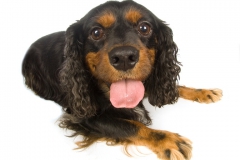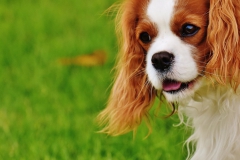Article about the difference between King Charles and Cavalier King Charles spaniels.
By Laure-Anne Viselé, June 2010. Re-released and updated on 3 May 2019
Photo credits at the end of the post
I am often surprised to see that that a lot of Cavalier King Charles Spaniels owners think it is the same breed as King Charles Spaniels. Dog geek that I am, I had to do some research. Here is what I found out:
Confusion all around
Even the professionals get confused, it seems. According to cavaliers.co.uk, “The media often incorrectly describes most Cavalier King Charles Spaniels in the press as being King Charles Spaniels.” Even vets get frequently confused, according to the same source, going as far as suggesting that a breed-conform King Charles is a breed-faulty Cavalier. In extreme cases, this can result in surgical procedures such as surgery for fused toes or undershot jaw or an incorrect hydrocephalus diagnosis (because the dog has a domed head). This begs the painful question of how much strict breed conformation actually trivialise malformations, but that’s a whole nother debate.
Features shared by both breeds
- Both fall under Group 9 (Companion and toy dogs)/Section 7 of the FCI (English toy spaniels).
- Both can have the following coat colours (over over the picture to get the colour name):
- Black and tan,
- Ruby,
- Blenheim (pronounce “blenam”) and
- Tricolour.
Traits unique to King Charles Spaniels
- FCI #: 128
- Character (FCI): Reserved (to whatever extent you can make solid character predictions for every single individual of a breed)
- Stop (FCI): (how pronounced the indentation of the forehead is) Well-defined
- Nose (FCI): Very short and turned up to meet the skull
- Jaw (FCI): Lower jaw wide, bite slightly undershot. Reminiscent of other ‘squashed-face’ dogs such as the pug.
- Ears (FCI): Set low
- Chest (FCI): Wide and deep
- Weight (FCI): 3.6 to 6.3kg, making them the smallest spaniel breed.
- Head (FCI): domed
- Foot (cavaliers.co.uk): Compact, with occasionally central pad and nails fused together
- History (FCI): Documented (in Great Britain) since at least 15th century
- Numbers (cavaliers.co.uk): In the year 2000, 185 were registered at the UK Kennel Club
Traits unique to Cavaliers King Charles Spaniels
- FCI #: 136
- Character (FCI): Fearless (again, carefuly with sweeping temperament generalizations based on average breed traits)
- Stop (FCI): Shallow
- Nose (FCI): Better developed
- Jaw (FCI): Regular and complete scissor bite
- Ears (FCI): Set high
- Chest (FCI): Moderate
- Weight (FCI): 5.4 to 8kg (so larger than King Charles)
- Head (cavaliers.co.uk): Skull almost flat between the ears
- Foot (cavaliers.co.uk): Compact
- History (cavaliers.co.uk): Not recognized (by UK Kennel Club) until 1945
- Numbers (cavaliers.co.uk): In the year 2000, over 11,000 were registered at the UK Kennel Club
What to look out for
I was at a veterinary neurology conference the other day and it made for the world’s most depressing Friday. One clinical case out of two was… a Cavalier King Charles. The breed is infamous for a flurry of neurological issues from light chasing to severe locomotory impairments.
Our advice? If you see the slightest oddity in your (Cavalier) King Charles, off to the vet you go.
If you find that they move in an uncoordinated way, if they press their head against the walls, if they develop an obsession (e.g. light spots, non-existent flies, their tail or their flank).
Do not see it as a cute quirk: have it checked.
Cavaliers and King Charles at our dog training school
We’ve actually never had a King Charles at OhMyDog, only Cavaliers. In our experience, they have been incredibly sociable, playful, intelligent students. The one on the picture if Peanut. She has had private and group training with us, and we love her to bits!

To book a course with us, please see an overview of our services (Dutch or English).
Sources
- Fédération Cynologique Internationale (international registry of breed standards)
- King Charles Spaniel or Cavalier King Charles Spaniel: There IS a difference (article by cavaliers.co.uk)
Any comments
We love to hear from you if you’d like to share your view on the topic. We’d particularly like to hear your comments:
- If you own the breed.
- Whether you would recommend or discourage people from getting these breeds? What are the pros and cons in your experience?
- If your breed (or mixed breed) also gets frequently confused for another breed.
- If you are often advised, even by pet professionals, that your King Charles is in fact “faulty Cavalier.
Photo credits
- Black and tan: Courtesy of Claire Mainwaring 08. Downloaded on 12 Apr 2019. License: CC BY-SA.
- Ruby: Courtesy of Cavalier King Charlles Spaniel (Wikipedia Commons user). Downloaded on 12 Apr 2019. License: CC BY-SA 4.0.
- Blenheim: Courtesy of Pixabay on Pexel. Downloaded on 12 Apr 2019. License: Pexel license.
- Tricolour: Courtesy of Bru-no. Downloaded on 12 Apr 2019. License: Pixabay.




